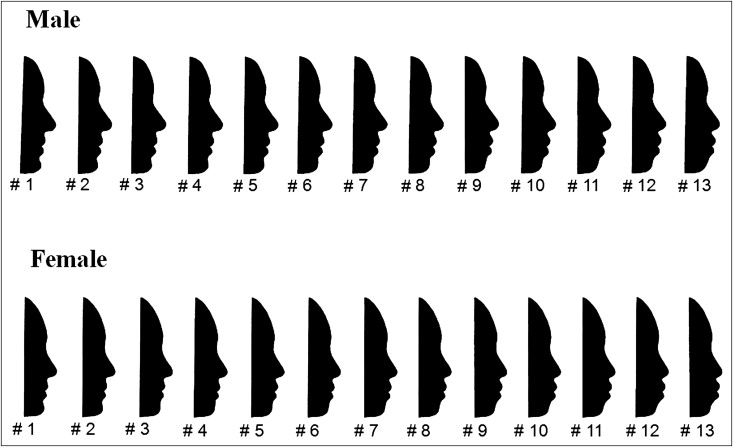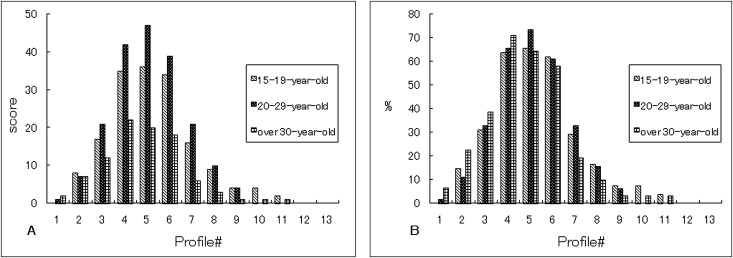Introduction
The purposes of this study were to assess and determine the range of a well-balanced anteroposterior lip position as evaluated by orthodontic patients from a series of varying lip positions in facial silhouettes, and whether the rater’s sex and age were factors in the assessment.
Methods
The average profiles were constructed from 30 Japanese male and female subjects with normal occlusion. A series of 13 profiles was developed for males and females, respectively. The lips were protruded or retruded by 1-mm increments from the average profile. One hundred fifty Japanese orthodontic patients were asked to choose the top 3 most-favored, well-balanced profiles for each sex.
Results
The orthodontic patients tended to prefer a slightly retruded lip position than the average facial profile for both the male and female profiles. There was no significant difference between male and female raters in selecting the top 3 most-favored profiles. In the comparison of age groups, the over 30-year-old patients significantly preferred a more retruded lip position than did the 15- to 19-year-old and the 20- to 29-year-old patients for the female profile.
Conclusions
These results suggest that, when we formulate a treatment plan, we should ask the patients about lip position before we start treatment.
Facial attractiveness influences personality development and social interactions. According to Miller, people mainly focus on another person’s eyes and mouth during interpersonal interactions, with little time spent on other facial features. Therefore, the mouth is a highly influential characteristic of facial attractiveness. Moreover, a large majority of orthodontic patients cite facial esthetics as a strong motivator for seeking treatment. Therefore, it is important to set treatment goals of creating a well-balanced and proportional face and obtaining well-aligned dental arches. Facial esthetics are often evaluated from a proportional aspect by using the lateral view of the face from cephalometric radiographs or facial photographs. In particular, the relationship between the lips and chin position is critical in evaluating the facial profile.
Many studies of a well-balanced Japanese facial profile were conducted between the 1950s and 1970s by Izuka and Ishikawa, Yamauchi, Yamauchi and Sakuda, Yamauchi et al, Iwasawa et al, and Shishikura. They reported that a pleasing Japanese female profile was characterized by a slightly retruded mandible having a large interincisal angle. However, the present Japanese perception of a pleasing facial profile might be changing to a more internationally pleasing one. Foster evaluated the profile preferences among various ethnic groups by using silhouettes. The results indicated that the diversified groups seemed to share a common esthetic standard for the posture of the lips within 1 to 2 mm in most cases. This is because young Japanese adults experience more exposure to mass media, such as the Internet and worldwide communications and travel. Therefore, it is important to determine whether the present orthodontic facial standards are an adequate reflection of today’s facial esthetic preferences.
The well-balanced Japanese profile has been evaluated by dental professionals and art students, who were professionally educated or disciplined in facial esthetics. Consequently, so far, no study has yet attempted to quantify the lip position of the most attractive Japanese profiles as evaluated by orthodontic patients. Shaw et al and Prahl-Andersen reported that dental professionals are conditioned to take an overly critical view of any deviation from the norm. Giddon emphasized that orthodontists must establish esthetic goals that correlate with the public’s standards at that time. In light of these facts, it is important to assess the well-balanced lip position as evaluated by orthodontic patients so that they will be satisfied with their orthodontic outcomes.
The purposes of this study were to assess and determine the range of well-balanced anteroposterior lip positions as evaluated by orthodontic patients from a series of varying lip positions in facial silhouettes, and to elucidate whether the rater’s sex and age were factors in the assessment.
Material and methods
This study was performed in accordance with the guidelines of the Helsinki Declaration (1996).
Average Japanese silhouettes were constructed from 30 cephalometric radiographs (15 men, 15 women) of patients aged 22 to 26 years. The inclusion criteria for this study were an ANB angle between 2° and 5°, normal occlusion with minor or no crowding, all teeth present except the third molars, no previous orthodontic treatment, and no prosthetic replacement of teeth.
The detailed methods for constructing an average Japanese facial profile were described in a previous article.
A series of 13 profiles was developed for men and women, respectively ( Fig 1 ). In the series, the average profile (number 7) was located in the center. The lips were protruded or retruded in 1-mm increments from the average profile, and the lip positions were changed parallel to the Frankfort horizontal plane. Profile number 1 was the most retrusive, and number 13 was the most protrusive.

The profile raters were 150 Japanese orthodontic patients 15 years of age or older, treated at Kyushu University Hospital (50 male; age, 22.7 ± 8.0 years; 100 female; age, 24.5 ± 8.8 years). Dental specialists, dental students, and art students were excluded from this study. The raters were asked to choose the top 3 most-favored, well-balanced profiles for each sex. We gave a score of 1 to each the top 3 most-favored profiles. The age distribution of the orthodontic patients is shown in Table I .
| Age (y) | Sex (n) | |
|---|---|---|
| Male | Female | |
| 15-19 | 21 | 34 |
| 20-29 | 22 | 42 |
| Over 30 | 7 | 24 |
Statistical analysis
Chi-square tests were used to compare the differences in the scores between the top 3 most-favored profiles and the other male and female profiles. This test was also used to compare the sex and age-group differences in selecting the top 3 most-favored profiles. A probability of less than .05 was considered to be statistically significant.
Results
The top 3 most-favored male profiles were numbers 5, 4, and 6 in that order ( Fig 2 , A ). The scores in these top 3 profiles were significantly higher than the secondary favored profiles ( P <0.05). The top 3 most-favored female profiles were numbers 4, 5, and 3 ( Fig 2 , B ). The scores in the top 3 profiles were not significantly higher than the secondary favored profiles. From the numbers 4, 5, and 6 profiles for the male profile and the numbers 3, 4, and 5 profiles for the female profile, the range of the following soft-tissue measurements was determined: lip protrusion to Sn-Pǵ and the esthetic line, Z-angle, and nasolabial angle for men and women ( Table II ). For the male profile, the most-favored lip protrusion values relative to Sn-Pǵ were 3.4 to 5.4 mm for the upper lip and 2.7 to 4.7 mm for the lower lip. The most-favored lip protrusion ranges relative to the esthetic line were –5.5 to –3.5 mm for the upper lip and –2.0 to 0 mm for the lower lip. The range of the most-favored Z-angle values was 72.0° to 75.0°. The range of most-favored nasolabial angle values was 104.0° to 107.0°. For the female profile, the ranges of the most-favored lip protrusion values relative to Sn-Pǵ were 2.5 to 4.5 mm for the upper lip and 2.4 to 4.4 mm for the lower lip. The most-favored lip protrusion ranges relative to the esthetic line were –4.5 to –2.5 mm for the upper lip and –1.5 to 0.5 mm for the lower lip. The range of the most favored Z-angle values was 73.0° to 75.0°. The range of most-favored nasolabial angle values was 109.0° to 115.0°. The 3 least-favored lip positions were numbers 11, 12, and 13 for both the male and female profiles ( Fig 2 ). From these 3 consecutive least-favored profiles, the range of the unesthetic lip protrusion values was determined ( Table III ).

| Variable | Range | |
|---|---|---|
| Male | Female | |
| Upper lip protrusion (Ls to Sn-Pǵ) (mm) | 3.4 to 5.4 | 2.5 to 4.5 |
| Lower lip protrusion (Li to Sn-Pǵ) (mm) | 2.7 to 4.7 | 2.4 to 4.4 |
| Upper lip to E-line (Ls to E-line) (mm) | −5.5 to −3.5 | −4.5 to −2.5 |
| Lower lip to E-line (Li to E-line) (mm) | −2.0 to 0 | −1.5 to 0.5 |
| Z-angle (chin-lip line to FH plane) (°) | 72.0 to 75.0 | 73.0 to 75.0 |
| Nasolabial angle (Cm-Sn-Ls) (°) | 104.0 to 107.0 | 109.0 to 115.0 |
| Variable | Range | |
|---|---|---|
| Male | Female | |
| Upper lip protrusion (Ls to Sn-Pǵ) (mm) | 10.4 to 12.4 | 9.5 to 11.5 |
| Lower lip protrusion (Li to Sn-Pǵ) (mm) | 9.7 to 11.7 | 9.4 to 11.4 |
| Upper lip to E-line (Ls to E-line) (mm) | 2.5 to 4.5 | 2.5 to 4.5 |
| Lower lip to E-line (Li to E-line) (mm) | 5.0 to 7.0 | 5.5 to 7.5 |
| Z-angle (chin-lip line to FH plane) (°) | 61.5 to 64.5 | 66.0 to 68.0 |
| Nasolabial angle (Cm-Sn-Ls) (°) | 93.5 to 96.5 | 88.0 to 94.0 |
For comparisons between the male and female raters, the top 3 most-favored male profiles were 5, 4, and 6 for both the male and female raters ( Fig 3 ). The top 3 most-favored female profiles were 4, 5, and 6 for the male raters and 4, 3, and 5 for the female raters ( Fig 4 ). Although the female raters tended to prefer a more retruded lip position than did the male raters, no significant difference was observed between the 2 groups.


For the comparison of age groups, the top 3 most-favored male profiles were 5, 4, and 6 for both the patients aged 15 to 19 and 20 to 29 years. These were 4, 5, and 6 in the over 30-year-old patients in that order ( Fig 5 ). The top 3 most-favored female profiles were 5, 4, and 6 in the 15 to 19-year-old patients and 4, 5, 3, or 6 in the 20 to 29-year-old patients. The order was 3, 4, and 2 in the over 30-year-old patients ( Fig 6 ). The over 30-year-old patients significantly preferred a more retruded lip position than the other age groups for the female profiles.





